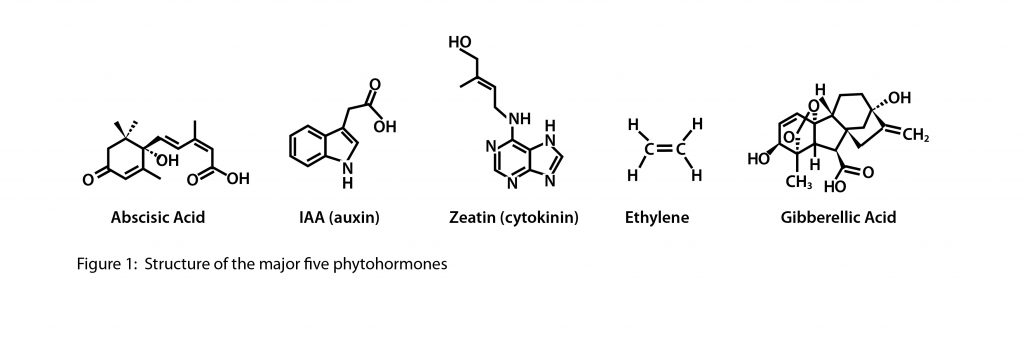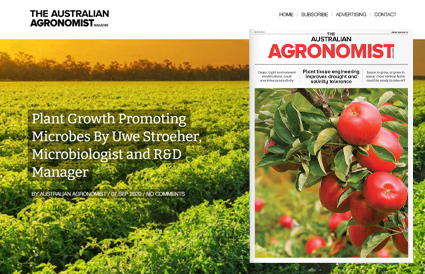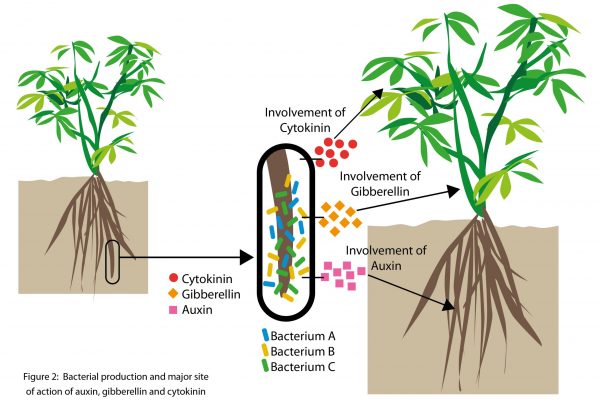
Plants naturally produce five major plant hormones (phytohormones) including auxins or indole-3-acetic acid (IAA), cytokinins, gibberellins, abscisic acid and the gaseous hormone, ethylene. It is a combination and balance of these hormones that regulate many aspects of plant growth, development and reproduction. The first three hormones are recognised as being plant growth promoting, whereas abscisic acid and ethylene are considered to be growth inhibitors due to their effect on plant abscission (the shedding away or cutting off of different parts of the plant) (Fig 1:).


However, plants are not the only organisms that produce these hormones. A range of soil microbes that either produce or influence these hormones are known as microbial phytohormones. In essence, the microbes in the soil and on the plant can influence plant growth and development. With a few exceptions, these microbes are generally bacteria, and so the term ‘plant growth-promoting bacteria’ (PGPB) has been coined. These PGPB not only produce phytohormones, but may also have other positive effects on plants such as pathogen suppression and nutrient acquisition. This article will focus on the essential role of the microbial-derived phytohormones.
As the world moves towards more sustainable agriculture, there has been a push to examine the use of biologicals to increase growth and yield. The current crop of biologicals on the market can be broadly divided into two classes – there are those that contain essentially active compounds i.e. phytohormones, and in some cases co-factors and nutrients for soil microbes and plants. The second class are those that use living microbes to introduce bacteria into the soil, which then grow and multiply, and release the phytohormones into the soil. Due to their versatility and in many cases longevity, there has been considerable interest in isolating and identifying these microbes.
The most widely studied of the bacterial phytohormones are auxins – in particular IAA. This is a small, readily diffusible molecule which bacteria produce, not as a phytohormone per se, but as a signalling molecule. Whilst bacteria use IAA to communicate with each other, the role of IAA in plant development is far-reaching. It can stimulate tuber and seed germination and control vegetative growth, it is perhaps best known for its effect on root development.
As plants normally produce IAA at the tip or shoots, this hormone then needs to be translocated to the roots, where high levels of IAA leads to lateral root formation. It therefore makes sense to encourage bacteria in the soil which naturally produce IAA, leading to not only enhanced root formation, but improved early seedling development and survival.
Evidence has recently come to light that IAA can also play a role in the defence response of a plant by reducing its susceptibility to pathogens. Due to the fact that IAA is also a bacterial signalling molecule, many genera of bacteria produce this compound, such as Bacillus, Streptomyces, Pseudomonas and Azotobacter to name a few. Some of these, in particular the Bacillus and Streptomyces species are long lived and can survive in soils even in unfavourable conditions. This makes them ideal candidates for soil inoculants such as Neutrog’s GOGO Juice.
The other major phytohormone involved in plant growth and development is cytokinin. At the correct levels this small molecule controls cell division in both roots and shoots. It is produced primarily in the roots of plants and then transported via the xylem to the rest of the plant. Production of cytokinins in the soil by bacteria allows plants to take up this hormone and translate it to the tips of the plant to enhance shoot development.
Besides their ability to enhance plant growth, evidence has also come to light that cytokinins produced by soil bacteria can improve the drought tolerance of some plants. As is the case for many hormones, the right levels can lead to increased growth, whereas excessive levels can cause damage. So although PGPB produce this hormone, it is at levels which enhance plant growth, but below concentrations which lead to plant growth inhibition. Alternatively, several plant pathogens produce high levels of cytokinins which then act in a growth inhibitory manner, making it easier for the pathogen to gain a foothold and damage the plant.
Another interesting global phytohormone is gibberellin or gibberellic acid (GA). It is involved in growth stimulation such as as stem elongation, seed germination, fruit set and even photosynthetic efficiency. GAs were first discovered in a fungi on rice plants where excess production of this phytohormone resulted in longer than normal internode lengths. The elongation of stems is one of the most notable effects of GA, and is seen most clearly in young stems. GA-producing microbes have seen only limited usage due to the difficulty in controlling the level of GA produced, however GAs have been used in commercial settings to increase flower buds and improve fruit production. It has also been applied to seedless grapes to increase bunch weight and size. Using gibberellin-producing bacteria to enhance plant growth is limited, as excessive amounts of this hormone can lead to damaging effects.
Although abscisic acid (ABA) is generally considered a plant growth inhibitory hormone, it plays a major role in how plants respond to stress. Sudden increases of ABA are known to be harmful to plants, however extensive evidence suggests that exogenous ABA coming from soil microbes can potentially reverse the effects of stress. As an example, inoculation of the soil with the ABA-producing bacteria Bacillus amyloliquefaciens has shown increased salinity tolerance in plants. It would appear that one role of ABA is to help plants maintain hydraulic conductivity of shoots and roots, thereby mitigating drought and salinity stress.
The phytohormone ethylene is generally considered an inhibitor of plant growth, and is produced in order to ripen fruit. It is also released from dying plant material and during periods of stress. It is in this stress setting where ethylene can create a series of events leading to plant death. Although microbes don’t produce this phytohormone, they can influence its effect. What we know is that a large number of soil microbes produce an enzyme know as 1-aminocyclopropane-1-carboxylate (ACC) deaminase. This enzyme essentially converts a precursor of ethylene into another compound, thereby reducing the amount of ethylene a plant can produce. As such, PGPB that produce ACC deaminase reduce the levels of ethylene to below inhibitory levels, resulting in a reduction in damage to the plant due to a stressor. Furthermore, inoculation of seeds or roots with bacteria capable of producing ACC deaminase also promotes root elongation and shoot growth by reducing ethylene levels which may otherwise inhibit development.

Figure 2: Bacterial production and major site of action of auxin, gibberellin and cytokinin.
These hormones work together in a coordinated manner to optimise plant development.
The question is how do we obtain the maximum benefit of these PGPB? For this we need to have soils with a wide and dynamic microbial population. This can best be achieved by the use of organic inputs (composts or mulches), which encourages diversity and can be further enhanced by inoculation with a probiotic such as GOGO Juice to colonise and populate the soil.
References:
1: Egamberdieva, D., Wirth, S J., Alqarawi, A. A., Abd-Allah, E. F., Hashem, A. Phytohormones and Beneficial Microbes: Essential Components for Plants to Balance Stress and Fitness. Frontiers in Microbiology (2017) vol 8 pg 2104
2: Glick, B.R. Plant growth-promoting bacteria: Mechanisms and Application. Scientifica (2012) Vol 2012
